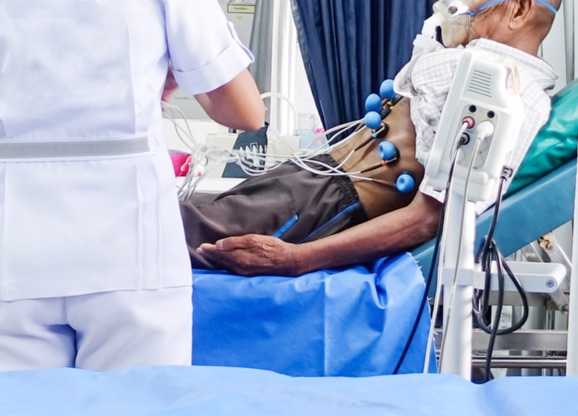My ICU patient with acute hypoxaemic respiratory failure is immunocompromised

My ICU patient with acute hypoxaemic respiratory failure is immunocompromised: Results from the EFRAIM study
EJRC Article Review
Over the past decades, the number of immunosuppressed patients admitted to ICUs has increased. This may be the consequence of increased use of chemotherapy, bone marrow and solid organ transplantation, as well as the increased life expectancy of patients with different solid tumours (1, 2). Acute respiratory failure (ARF) is the leading cause of ICU admission for these patients and its management may be challenging starting from the diagnosis of its aetiology to the selection of the least dangerous method to treat hypoxia (1).
The EFRAIM study was a multinational prospective cohort study, which enrolled 1611 immunocompromised patients from 68 ICUs. Patients were affected by a non-AIDS related immune deficiency (haematologic or solid tumours, solid organ transplant and steroids/immunosuppressive therapy) and hypoxaemic ARF (3). Primary endpoints were the need for invasive mechanical ventilation (IMV) for patients not intubated at ICU admission, and all-cause hospital mortality.
Thirty-seven patients were intubated at ICU admission and received IMV, while 54.2% received standard oxygen, 20.4% high-flow nasal cannula (HFNC), 16.7% noninvasive ventilation (NIV) and 8.6% received both HFNC and NIV. After propensity score matching, only HFNC, not NIV had an effect on IMV rate (HR 0.77, 95% CI 0.59 – 1.00), but the authors did not identify any association between the adopted oxygenation strategy and mortality rate. However, when HFNC failed and IMV was required, authors observed the highest odds for mortality [5.54 (3.27 – 9.38)] compared with IMV following failure of other oxygenation strategies [OR for NIV failure 4.16 (2.91 – 5.93)]. Cause of ARF was undetermined in approximately 13% of cases and this patient group was at higher risk for intubation and death compared to other (recognised) ARF aetiologies (3). The higher risk of mortality may be the result of failure to provide adequate treatment for unidentified pathogens or failure to recognise an atypical pulmonary involvement of the underlying disease.
Recently, Lemiale and colleagues compared the use of NIV to oxygen therapy in immunocompromised patients with ARF showing a lack of benefit of early NIV for mortality reduction at 28-days (4). However, this trial had different limitations. Indeed the mortality of the control group was unexpectedly low leading to an inadequate study power. HFNC was used in almost 40% of overall patients, especially in the oxygen group, probably leading to a dilution of the NIV effect (4). Finally, NIV was used for a median duration of respectively 8, 6 and 5 hours during the first three days from randomisation, which has been considered inadequately low according to current practice in different centres (5). Available evidence seems to reconsider the role of NIV for immunocompromised patients given the lack of benefit over HFNC and probably standard oxygen. The potential of self-inflicted lung injury (i.e. lung injury sustained by high transpulmonary pressure in a spontaneously breathing patient) has been claimed as a potential contributor of declined oxygenation and even increased mortality of NIV compared to HFNC and standard oxygen (6). Undetermined cause of ARF was independently associated with an increased intubation rate and IMV (which are by themselves risk factors for mortality). However, lack of recognition of ARF aetiology may lead to increased hospital mortality per se (3).
Take Home Message
So what are the management goals of hypoxic immunosuppressed patients?
There remains no clear evidence support NIV over oxygen in the attempt to avoid intubation. Clinicians, on the other hand, may consider intubation for diagnostic purposes (e.g. bronchoalveolar lavage), but it is not clear whether efforts to reach a diagnosis outweigh the risks associated with intubation and IMV. A powered randomised study is needed to provide data for these challenging, unanswered questions.
This article review was prepared and submitted by EJRC member Vincenzo Russotto, Department of Emergency and Intensive Care. University Hospital San Gerardo, Monza, Italy.
References
- Hui-Bin Huang, Biao Xu, Guang-Yun Liu et al. Use of noninvasive ventilation in immunocompromised patients with acute respiratory failure: a systematic review and meta-analysis. Crit Care 2017; 21:4
- Salvadori M, Bertoni E. What’s new in clinical solid organ transplantation by 2013. World J Transplant. 2014;4(4):243–66
- Azoulay E, Pickkers P, Soares M et al. Acute hypoxemic respiratory failure in immunocompromised patients: the Efraim multinational prospective cohort study. Intensive Care Med 2017;(12): 1808-19 (FREE ACCESS LINK)
- Lemiale V, Mokart D, Resche-Rigon M, et al. Effect of noninvasive ventilation vs oxygen therapy on mortality among immunocompromised patients with acute respiratory failure. JAMA. 2015;314(16):1711.
- Navalesi P, Gregoretti C, Antonelli M. Noninvasive Ventilation and Outcomes Among Immunocompromised Patients. JAMA. 2016;315(17):1902
- Frat JP, Thille AW, Alain M. High-Flow Oxygen through Nasal Cannula in Acute Hypoxaemic Respiratory Failure. N Engl J Med 2015; 372:2185-2196
Related icTV Content
In this icTV interview, Elie Azoulay discusses the recent Nine-i network study, the results of which were presented in the President’s session at LIVES 2017 in Vienna: